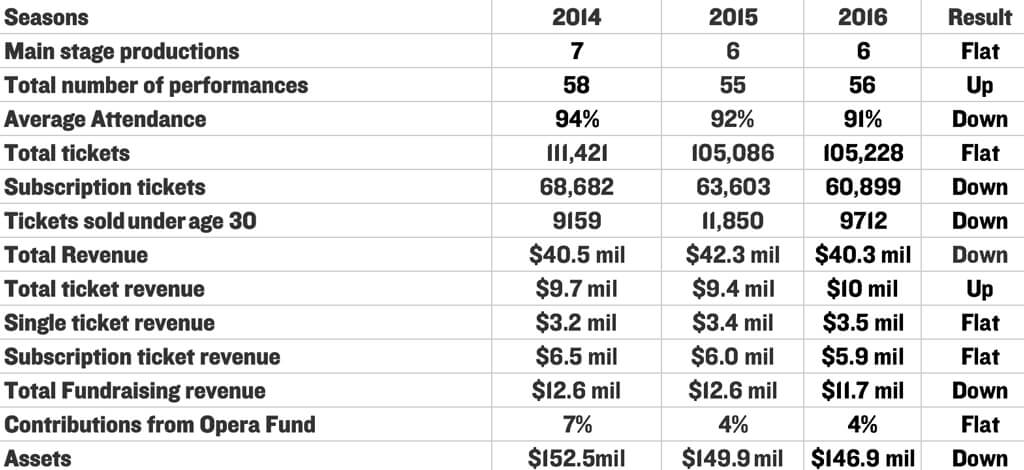
After a troubling year of opera company closures in North America (Boston Metro Opera, Dicapo Opera, Gotham Chamber Opera, Opera Lyra Ottawa), we might call this the “age of opera anxiety.” But closer to home, Toronto’s opera scene has proven to be a rare island of success in a sea of fiscal uncertainty.
The 2015 annual report by the Canadian Opera Company showed that it was a “no news is good news” situation, and this year is no different.
The 2015–16 annual report affirmed the COC earned a modest $32,000 surplus confirming a company with a clear vision towards sustainable growth.
Comments by COC General Director Alexander Neef suggested that a return to a six-opera season has been the panacea they’ve been looking for to stem their reliance on the Canadian Opera Foundation, and seeing them through the challenges of rising costs.
“The positive outcomes of this multi-year self-reinvention are evidenced by the fact that, for the second year in a row, the company did not require additional support from reserve funds to break even, and that transfers from the Canadian Opera Foundation were reduced to less than 4% of total Endowment holdings, both significant achievements,” said COC Board Chair Colleen Sexsmith.
A Closer Look

Analysis
The 2015 report showed that average attendance has been dropping steadily at the COC, from 94% in 2014 to 91% in 2016. While numbers in the 90’s may not be cause for alarm now, the overall trend is still pointing downward. The COC are not alone, as presenters all across North American have been reporting a struggle to compete with the increasing variety of entertainment options available to patrons, both inside and outside of the home.
There was also a modest decrease in attendance for the under 30 “Golden Ticket” demographic, from 11,850 to 9,712. This is no surprise, but the good news is that elusive Millennial audience has been flocking to Toronto’s booming indie opera scene, which the COC has astutely recognized as an ideal incubator for generating interest in the art form. These are the same generation whom the COC are betting will be the next generation of opera lovers at the COC.
While transfers from the Canadian Opera Foundation remained steady at $1.365M the COC have been taking advantage of low borrowing costs by taking out a $2.5M line of credit in the 2015 fiscal year. The closing balance of that liability rested at $971,000 at the close of 2015 and increased to $1.54M in 2016. Sure, they haven’t touched reserve funds for two years, but have they replaced one problem with another?
One area where the COC deserves some credit is with their overall expenses. In the past few years, the COC has struggled with decreasing revenue and increasing cost. Although revenues remained flat in 2016, the COC was successful in decreasing their costs in almost every expense category. In an age where one would assume a 3% inflationary increases year-over-year, seeing a reduction in overall expenses of nearly 5% is an accomplishment. Hopefully, this is the beginning of a trend, where the COC realize that focusing on revenue is not sufficient; finding efficiencies in their operations is also pivotal to their success.
#LUDWIGVAN
Want more updates on Toronto-centric classical music news and review before anyone else finds out? Follow us on Facebook or Twitter for all the latest.
- THE SCOOP | Royal Conservatory’s Dr. Peter Simon Awarded The Order Of Ontario - January 2, 2024
- THE SCOOP | Order of Canada Appointees Announced, Including Big Names From The Arts - December 29, 2023
- Ludwig Van Is Being Acquired By ZoomerMedia - June 12, 2023



